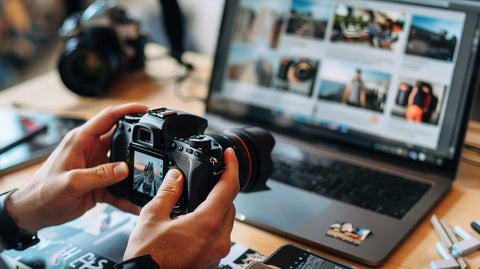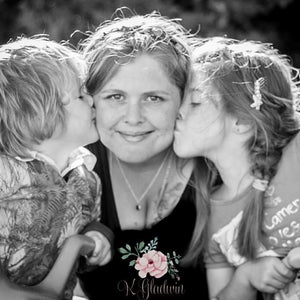- Lightroom Presets
- Mobile Presets
-
Photoshop
-
Learn
-
Support
-
Install
- Best Sellers
- Blog
By Kelly-Anne Gladwin on | No Comments

We're so excited to have Kelly Gladwin with us today for our Editing Like a Pro Series! Kelly has been inspiring the Pretty Presets and Actions community for over 6 years now. We've been amazed as she started in Lightroom and then jumped into Photoshop overnight to master her art.
Kia ora guys and gals. My name is Kelly Gladwin, and I live in beautiful New Zealand. Today, I'm going to walk you through using the sky replace feature in Photoshop and then I will show you how how to make it look natural by blending it with the original image.
I will walk you through my typical workflow, step by step, which I used on this image (and almost all of my other edits)!
Finally, I will include some simple & effective editing tips I have learned over the years!
Personally, I like to begin my editing in Lightroom (which comes as part of the Adobe Creative Cloud subscription) before I move the image into Photoshop.
Once I have my image opened in Lightroom, I start by cropping it to get my desired frame. Then I apply a preset. For this example, I used the Dune preset from Pretty Film Bohemian.

Once your done in Lightroom, its time to move over to Photoshop to add a sky overlay. To do this, I export my image from Lightroom using the dimensions described in this export cheatsheet. Then I open my image in Photoshop.
Helpful tip: While in Lightroom, you can right-click on the image before exporting it and choose to send it directly to Photoshop for further editing. Or, you can use Lightroom Shortcut CMD/CTRL + E to make it even easier.
I always start out in Photoshop by duplicating my background layer. I like to do this so I can use the Bandaid Healing Tool or the Clone Stamp to remove any distractions and unwanted stuff from my image. In this example, I removed a few clumps of weeds/grass and a post or two from the fence. Once my image is clear of distractions, I FLATTEN the layers.

To add a new sky, I like to use the Sky Replace Actions that come free with all Pretty Preset's Sky Overlay Collections like Painted Skies. For this image I used the Overcast option because my image was shot in the fog. For other images, the "blown out" option works better.

You can also use Photoshop's new built in Sky Replacement Tool. It doesn't include all the features of Pretty's Sky Replace Actions, but it will do the trick.
Once you are prompted, select your sky from the location on your computer where your sky images are located. Then resize, scale and position the sky where you want it on your image. When everything looks right, hit enter.
In your layers panel, you will now have a list of layers and options. When working with layers, always start from the bottom up, as when we are editing an image, we are building a foundation for the finished product/image.
Select the layer mask on 'Cloud Overlay' and, if needed, brush off your sky using a soft black brush at 100% opacity from areas where it it isn't showing --usually in the highlights etc.
Then, start moving up the list. Working in the layer mask and working with the LAYER opacity (not the brush opacity), to create the desired look of your chosen sky, while also trying to keep it looking natural and matching your existing image.
Helpful Tip: On each layer where I use brushes on a layer mask, I also add a gaussian blur. When I do this, I may have to go back and refine my brushing to remove it from certain areas where it gets spread over more pixels than I intend.
I'm not a fan of hard brush lines and the this effect will blur the brush work and spread it out, creating a naturalness to the brushing that will really make an image pop! Sometimes I blur the layers as I go, and sometimes not until I'm almost finished with an image.
When adding a gaussian blur, my ideal amount of blur is 72.8. Gaussian blur is a game-changer and it will elevate your images when your brushwork is utilized in this way.

Finally, once all of the layer adjustments are complete, I flatten my image.
Congratulations! If you have been following along with your own sky replacement, your image should now have a beautiful new sky!
Here is my final image with its new sky. What a difference!

Here are 8 additional tips to help you blend your skies seamlessly and add that extra "WOW" to your photos with some "after-edits" and "lightscaping" that I like to do to my images using Pretty Preset's PURE Color Workflow collection!
Tip #1: All skies fade on the horizon. So in the layers option of SKY FADE try adding more or less sky fade. To do this, adjust the opacity as needed (on that layer only).
Tip #2: If you are working with an image that was shot at F1.8 (or shot really wide) and try to replace the sky on that image, your sky will look off and artificial IF you don't take the time to blur it to match. This is a super important step that cannot be missed or your image will not look right.
As mentioned above, adjust the layer panels opacity. Personally, I like to have a thin band across the top of my image that is in more focus than the rest of the sky (as the top of the image is closer than the background of the image, it will appear more in focus when you observe the skies in real life).
Tip #3: When selecting which sky to use, make sure it matches your subject in light, shadow, sun direction, colors, tones and mood.
Tip #4: The opacity of your sky overlay doesn't have to be at 100%. You can tone it down by lowering that layer's opacity. This is especially handy when you have a lot of tree foliage where the sky is not blending very well into the leaves. To correct for this, slowly chip away at the edges using a low opacity brush and gaussian blur as you go.

Tip #5: The sky overlay will rarely sit directly on your horizon and will often overlap onto your image. If this is the case, you may need to brush off the edges of the sky overlay by using a large black brush at at 20% opacity and tap away at it until the harsh line is removed.
Tip #6: I like to add a sun flare to many of my images too. The Warm Sun Glow from PURE Color Workflow is one of my favorite options. CTRL + T will let you resize it and position the sun flare just where you want it. Then adjust the opacity of the sun flare as needed.
The Warm Hazy Light brush (also from PURE Color Workflow) is another fantastic option if you would like to PAINT ON the sun flare. Using a soft black brush at low opacity (18-30%), brush on where you would like your flare to be and slowly build it up from there, keeping in mind how light reacts with shadow, existing highlights and your sky.

Tip #7: I like to make my subject 'POP' or standout on many of my images and the Mini Retouch Kit that's also included in PURE Color Workflow collection makes this easy!
When retouching, I recommend to continuously turn on/off the layer you're working in to see if you are overdoing it or not. This will help keep your subject looking natural and ensure your brushwork stays natural (which is especially handy, when your are retouching eyes because it is easy to over edit them to the point that they look fake).
Some of the other things I like to do (as needed) include using the selective sharpen brush on my subjects features, adding a soft vignette, darkening or brightening the exposure, taming color casts, adding Center Light (sometimes even more than one which I use to highlight the area behind and around the subject to help them pop even more. Whatever I feel the image needs!

Tip #8: Learn how to invert your layer mask from black to white and vice versa (select your layer mask and click Photoshop keyboard shortcut CMD/CTRL + I). This will come in handy when adding a new sky.
With some skies its easier to cover the entire image and then erase off using brushes. And with other skies its easier to apply onto the image using brushes. Knowing how and when to use these two options in Photoshop will make your workflow faster and easier.
Tip #9: An additional step that I like to do for what I call "Lightscaping" is to utilize Photoshop's Color Sample Dropper: using the Eye Dropper Tool on a new layer, I sample the brightest part of the sky replacement and brush the selected tones on where highlights would fall. This is "especially" handy for horizon lines, hair and fur etc.
I usually sample 3 different tones from the sky (light, mid-tone and semi mid-tone). So in this step, I will create 3 different layers (gaussian blurring, brushing off and adjusting layer opacity as needed to get a natural color cast).
This step will really make a BIG difference when blending of your new sky into the original image!

So there you have it - this is my complete workflow that I used on this image and use on most of my other images too!
I hope these tips help you with your own sky replacements, inspire you to try something new, or maybe just give you an "A-HA" moment.
If at any point you get stuck, I highly recommend following along with Pretty Presets & Actions free tutorials on their website. Or if you're looking to learn Photoshop from start to finish, their Photoshop 101 course is invaluable and a real game-changer if you are new to Photoshop.
Thanks for reading and you can catch me over at Chick-inn Ma'am Photography on Facebook. Ka kite, e noho ra.
Do you have any questions or comments about How to Replace a Sky in Photoshop? Leave us a comment below - we would love to hear from you! And PLEASE SHARE this post using the social sharing buttons (We really appreciate it)!




Kelly is a fine art photgrapher from the bottom of New Zealand who can be found spending her time photographing her children, animals and the beautiful the night sky. You can find Kelly on her Facebook page at Chick-inn Ma'am Photography.

Comments